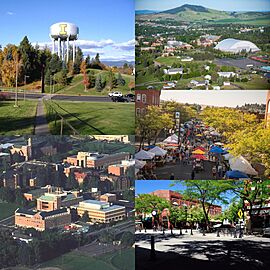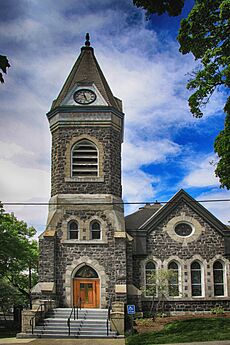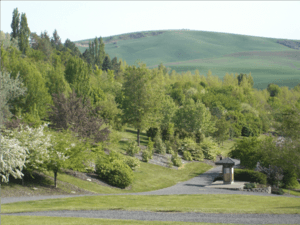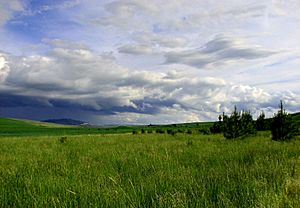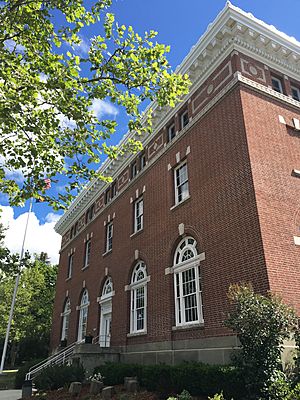Moscow, Idaho facts for kids
Quick facts for kids
Moscow, Idaho
|
|||
|---|---|---|---|
|
City
|
|||
|
Clockwise from top: Aerial view of Moscow, Kibbie Dome, Moscow Farmer's Market, Downtown Moscow, University of Idaho campus, water tower on campus
|
|||
|
|||
| Motto(s):
Heart of the Arts
|
|||
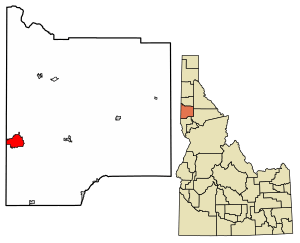
Location of Moscow in Latah County, Idaho.
|
|||
| Country | United States | ||
| State | Idaho | ||
| County | Latah | ||
| Settled | 1871 | ||
| Incorporated (town) | 1887 | ||
| Incorporated (city) | 1893 | ||
| Government | |||
| • Type | Mayor–council | ||
| Area | |||
| • Total | 6.91 sq mi (17.90 km2) | ||
| • Land | 6.91 sq mi (17.89 km2) | ||
| • Water | 0.00 sq mi (0.01 km2) | ||
| Elevation | 2,582 ft (787 m) | ||
| Population
(2020)
|
|||
| • Total | 25,435 | ||
| • Density | 3,720.08/sq mi (1,436.28/km2) | ||
| Time zone | UTC−8 (Pacific) | ||
| • Summer (DST) | UTC−7 (Pacific Daylight) | ||
| ZIP code |
83843
|
||
| Area code(s) | 208 | ||
| FIPS code | 16-54550 | ||
| GNIS feature ID | 2411172 | ||
| Website | ci.moscow.id.us | ||
Moscow (pronounced MOSS-koh) is a city in Idaho, USA. It is the main city and county seat of Latah County. This means it's where the county's government offices are located.
Moscow is in the north-central part of Idaho, right next to the border with Washington. In 2020, about 25,435 people lived here. Moscow is famous for being home to the University of Idaho. This is a special type of university called a "land-grant institution" that focuses on teaching, research, and helping the community.
Moscow is the biggest city in its local area, called the Moscow, Idaho Micropolitan Statistical Area. This area includes all of Latah County. More than 60% of the county's people live in Moscow. While the university is the biggest employer, Moscow is also a key place for farming and business in the Palouse region.
Like other parts of northern Idaho, Moscow is in the Pacific Time Zone. The city center is about 2,579 feet (786 meters) above sea level. Two main highways, US-95 and ID-8, run through the city. The Pullman–Moscow Regional Airport, about 4 miles (6.4 km) west, offers some flights. The local newspaper is the Moscow-Pullman Daily News.
Contents
Discover Moscow's Past
After the American Civil War, miners and farmers started moving to northern Idaho. The first people to settle permanently in the Moscow area arrived in 1871. They found lots of camas bulbs, which pigs loved to eat. Because of this, they first called the area "Hog Heaven."
When the first post office opened in 1872, the town was named "Paradise Valley." But in 1875, the name was changed to "Moscow." The main stream flowing through town is still called Paradise Creek.
How Moscow Got Its Name
The exact reason for the name Moscow is a bit of a mystery. Some people think it's connected to the big city of Moscow, Russia, maybe named by Russian immigrants. Others say it came from a Native American tribe called "Masco."
Early settlers said that five men tried to pick a name for the town but couldn't agree. So, the postmaster, Samuel Neff, chose "Moscow" for the official papers. Interestingly, Neff was born in Moscow, Pennsylvania, and later lived in Moscow, Iowa.
By 1875, Moscow had a business district and became an important trade center. By 1890, with new railroad lines from the Union Pacific Railroad and Northern Pacific Railroad, the town's population grew to 2,000 people.
University of Idaho's Founding
In the late 1880s, the Washington Territory was close to becoming a state. People in northern Idaho wanted their region to join Washington or become a separate state. This was because their trade and travel mostly went west, not south to Boise.
To keep the northern residents happy, the Idaho government decided to put the new land-grant university in Moscow. At that time, Moscow was the largest city in Idaho besides Boise. The University of Idaho was officially started in January 1889 and welcomed its first students in October 1892.
Just a few months later, in March 1890, the nearby city of Pullman was chosen for Washington's land-grant university. This college later became Washington State University.
Moscow City Hall and Old Post Office
The building that is now Moscow's City Hall was originally built in 1910 as the city's post office. It's a historic building that has served the community for over a century.
Moscow Public Library: A Century of Stories
In 1902, two women's clubs, the Pleiades Club and the Ladies' Historical Club, started a small library. In 1904, they planned to raise money for a new building. Andrew Carnegie, a famous businessman, offered $10,000 if the community promised to support the library with at least $1,000 each year.
Moscow voters agreed to a permanent tax in 1905. With more fundraising, construction began that same year. In March 1906, the new library building, designed in the Mission Style, was ready.
Right after it opened, a fire destroyed the main building at the University of Idaho. So, the new library was used for university classes during the day and as a public library in the evenings. By 1907, it was fully back to being a library. The original building was expanded in 1931 and 1983. It has a children's room named after Moscow author Carol Ryrie Brink. She wrote Caddie Woodlawn, which won a special award in 1936.
In 2006, the library celebrated 100 years of service. Today, the Moscow Public Library is part of the Latah County Library District. It holds about 60% of the district's 100,000 books and other items. The library offers programs for all ages, like story times for kids and book clubs for teens and adults. It also provides public computers and free Wi-Fi.
As one young writer said in 2006, "Libraries are valuable and available to everyone, regardless of wealth. Anyone can and everyone should get a library card."
Downtown Moscow's Changes
In the late 1970s, new shopping malls opened, drawing many stores away from Moscow's older downtown area. To help downtown, the city started a project in the early 1970s to make changes. In 1981, they changed how traffic flowed on Main Street.
Main Street used to have four busy lanes. Now, highway traffic from US 95 was sent to one-way streets nearby: Washington Street for northbound traffic and Jackson Street for southbound traffic. This helped reduce traffic jams and made downtown safer for people walking. Main Street became a two-lane street with angled parking, and new trees were planted.
Over the years, more changes were made to these traffic routes to make them safer and smoother. Some old buildings were removed to create space for these new roads.
Another big change for businesses happened in April 1987. The legal drinking age in Idaho was raised to 21, after being 19 for about 15 years. Many places that depended on customers who were 19 or 20 had to change how they operated or even close.
A tall concrete building, the grain elevators on south Main Street, was a familiar sight in Moscow for almost 100 years. It was torn down in March 2007. Another large set of grain elevators on Jackson Street was saved by a group that wanted to preserve it in 2007.
Moscow's Geography and Nature
Moscow is located on the eastern edge of the Palouse region in north-central Idaho. To the east of the city are mountains like Moscow Mountain, which is about 4,983 feet (1,519 meters) high. Paradise Creek flows through Moscow and eventually joins the Palouse River, which then flows into the Snake River and Columbia River on its way to the Pacific Ocean.
The land around Moscow has different types of rock and soil. There are very old granite rocks, and fertile rolling hills made of deep soil called loess, which was blown here by winds after the last ice age. There are also channels carved by ancient floods.
Moscow is home to various plants and animals. You can find the Rough-skinned Newt here, which usually lives along the Pacific coast. The city sits where the grassy Palouse fields meet the conifer forests of the Rocky Mountains.
Moscow's Weather
Moscow has a climate with warm summers. Summers are usually dry, and winters are cool and wet.
| Climate data for Moscow, Idaho (University of Idaho), 1991–2020 normals, extremes 1893–present | |||||||||||||
|---|---|---|---|---|---|---|---|---|---|---|---|---|---|
| Month | Jan | Feb | Mar | Apr | May | Jun | Jul | Aug | Sep | Oct | Nov | Dec | Year |
| Record high °F (°C) | 58 (14) |
66 (19) |
73 (23) |
88 (31) |
94 (34) |
105 (41) |
105 (41) |
109 (43) |
100 (38) |
88 (31) |
73 (23) |
61 (16) |
109 (43) |
| Mean maximum °F (°C) | 49.5 (9.7) |
53.5 (11.9) |
64.6 (18.1) |
74.8 (23.8) |
83.2 (28.4) |
88.6 (31.4) |
96.6 (35.9) |
98.2 (36.8) |
91.9 (33.3) |
78.3 (25.7) |
60.2 (15.7) |
49.4 (9.7) |
99.1 (37.3) |
| Mean daily maximum °F (°C) | 37.4 (3.0) |
42.0 (5.6) |
50.1 (10.1) |
58.0 (14.4) |
67.3 (19.6) |
73.4 (23.0) |
84.4 (29.1) |
85.6 (29.8) |
76.2 (24.6) |
60.5 (15.8) |
44.9 (7.2) |
36.4 (2.4) |
59.7 (15.4) |
| Daily mean °F (°C) | 29.8 (−1.2) |
32.9 (0.5) |
39.0 (3.9) |
45.0 (7.2) |
52.6 (11.4) |
57.7 (14.3) |
64.9 (18.3) |
65.4 (18.6) |
57.9 (14.4) |
46.6 (8.1) |
36.2 (2.3) |
29.0 (−1.7) |
46.4 (8.0) |
| Mean daily minimum °F (°C) | 22.2 (−5.4) |
23.8 (−4.6) |
28.0 (−2.2) |
32.0 (0.0) |
37.9 (3.3) |
42.0 (5.6) |
45.3 (7.4) |
45.2 (7.3) |
39.7 (4.3) |
32.8 (0.4) |
27.4 (−2.6) |
21.6 (−5.8) |
33.2 (0.6) |
| Mean minimum °F (°C) | 4.2 (−15.4) |
9.8 (−12.3) |
16.8 (−8.4) |
24.9 (−3.9) |
28.2 (−2.1) |
33.7 (0.9) |
37.3 (2.9) |
36.2 (2.3) |
29.0 (−1.7) |
20.1 (−6.6) |
13.2 (−10.4) |
5.7 (−14.6) |
−4.8 (−20.4) |
| Record low °F (°C) | −26 (−32) |
−26 (−32) |
−10 (−23) |
11 (−12) |
19 (−7) |
28 (−2) |
31 (−1) |
30 (−1) |
20 (−7) |
2 (−17) |
−14 (−26) |
−42 (−41) |
−42 (−41) |
| Average precipitation inches (mm) | 3.33 (85) |
2.56 (65) |
3.05 (77) |
2.75 (70) |
2.60 (66) |
1.73 (44) |
0.66 (17) |
0.70 (18) |
1.01 (26) |
2.40 (61) |
3.52 (89) |
3.47 (88) |
27.78 (706) |
| Average snowfall inches (cm) | 14.5 (37) |
8.6 (22) |
4.9 (12) |
1.0 (2.5) |
0.2 (0.51) |
0.0 (0.0) |
0.0 (0.0) |
0.0 (0.0) |
0.0 (0.0) |
0.2 (0.51) |
6.0 (15) |
15.5 (39) |
50.9 (128.52) |
| Average extreme snow depth inches (cm) | 9.0 (23) |
5.3 (13) |
2.5 (6.4) |
0.1 (0.25) |
0.0 (0.0) |
— | — | 0.0 (0.0) |
0.0 (0.0) |
0.0 (0.0) |
2.5 (6.4) |
7.0 (18) |
11.7 (30) |
| Average precipitation days (≥ 0.01 in) | 16.0 | 13.9 | 15.5 | 13.4 | 11.4 | 9.3 | 4.4 | 3.6 | 5.5 | 10.9 | 16.1 | 15.9 | 135.9 |
| Average snowy days (≥ 0.1 in) | 6.3 | 5.0 | 3.2 | 1.1 | 0.3 | 0.0 | 0.0 | 0.0 | 0.0 | 0.3 | 3.2 | 7.8 | 27.2 |
| Source 1: NOAA | |||||||||||||
| Source 2: National Weather Service | |||||||||||||
People of Moscow
| Historical population | |||
|---|---|---|---|
| Census | Pop. | %± | |
| 1880 | 76 | — | |
| 1890 | 1,280 | 1,584.2% | |
| 1900 | 2,484 | 94.1% | |
| 1910 | 3,670 | 47.7% | |
| 1920 | 3,956 | 7.8% | |
| 1930 | 4,476 | 13.1% | |
| 1940 | 6,014 | 34.4% | |
| 1950 | 10,593 | 76.1% | |
| 1960 | 11,183 | 5.6% | |
| 1970 | 14,146 | 26.5% | |
| 1980 | 16,513 | 16.7% | |
| 1990 | 18,519 | 12.1% | |
| 2000 | 21,291 | 15.0% | |
| 2010 | 23,800 | 11.8% | |
| 2020 | 25,435 | 6.9% | |
| U.S. Decennial Census 2020 | |||
In 2010, Moscow had 23,800 people living in 9,180 households. About 22.9% of households had children under 18. The average age in the city was 24.2 years. Many residents were young, with 36.1% being between 18 and 24 years old.
Fun Things to Do in Moscow
Moscow is known as the "Heart of the Arts" and has many cultural events.
| Name | Dates | Location | Notes |
|---|---|---|---|
| Lionel Hampton Jazz Festival | April, second to last weekend | Multiple venues | Main concerts: Idaho Central Credit Union Arena |
| Moscow Hemp Fest | April, mid-month | East City Park | |
| Renaissance Fair | May, first weekend | East City Park | Multiple stages and events |
| Farmers Market | May–October, Saturdays | Main Street | 8am - 1pm |
| Rendezvous in the Park | July, third week | East City Park | |
| Light up the Night Parade | December 1 | Main Street |
Parks and Outdoor Activities
Moscow has seventeen neighborhood parks for outdoor fun. The Moscow Parks and Recreation Department manages these parks. There's also a group working to create a system of connected parks and trails throughout the area. Carol Ryrie Brink Nature Park is a special park where Paradise Creek was restored, and new plants were added.
The community, especially local youth, helped raise money to build a skate park in Moscow, which opened in 2000. The city also has a modern aquatics center, the Hamilton-Lowe Aquatics Center, which opened in June 2000.
Trails for Biking and Walking
Moscow has great trails for biking and walking. The Latah Trail, finished in 2008, goes from Moscow to Troy for about 12 miles (19 km). On the west side of Moscow, the Bill Chipman Palouse Trail connects Moscow to Pullman, Washington, for about 8 miles (13 km).
The Paradise Path connects these two trails within Moscow, passing through the University of Idaho campus. Together, these trails form a continuous 22-mile (35 km) paved path from Pullman to Troy, perfect for outdoor adventures. These trails follow old railroad lines.
Education in Moscow
Colleges and Universities
The University of Idaho (U of I) is Idaho's oldest public university. It's the state's main university for research and is a "land-grant" school. It was the only university in Idaho for 71 years until 1963. Its law school started in 1909.
The university opened in 1892 with 40 students. Today, it has over 12,000 students, with most on the Moscow campus. U of I offers 142 different degree programs, from bachelor's to doctoral degrees. It also does a lot of research, bringing in $100 million in 2010 alone.
The U of I campus in Moscow is the largest in the state, covering 1,585 acres (6.4 km²). The school's sports teams are called the Idaho Vandals. Besides the main campus, U of I has smaller campuses in other Idaho cities like Boise and Coeur d'Alene.
New Saint Andrews College, another college, opened in 1994 and moved to its current Moscow campus in 2003.
Schools for Kids
The Moscow School District #281 serves the entire city. It includes:
- Moscow High School (grades 9-12)
- Paradise Creek Regional High School (an alternative high school for grades 10-12)
- Moscow Middle School (grades 6-8)
- Four elementary schools:
- Lena Whitmore Elementary School (K-5)
- A.B. McDonald Elementary School (K-5)
- West Park Elementary School (K-2)
- Palouse Prairie Charter School (K-8)
There are also two public charter schools and three private schools in Moscow.
Getting Around Moscow
Roads and Highways
US-95 connects Moscow to cities like Coeur d'Alene and Lewiston. ID-8 goes east-west through Moscow, connecting to Pullman in the west and Troy in the east.
Air Travel
The Pullman–Moscow Regional Airport is about 4 miles (6.4 km) west of Moscow. Other nearby airports include Lewiston-Nez Perce County Airport (34 miles south) and Spokane International (90 miles north).
Bus Services
The Moscow Intermodal Transit Center is where local and intercity buses operate. SMART (Sustainable Moscow Area Transit Service) provides local bus service. You can also catch buses to Spokane and Boise from here.
Biking in Moscow
The Paradise Path is a great path for biking and walking that goes through Moscow. It connects shopping centers, the University of Idaho, and city parks. There are also bike lanes and shared road markings to help cyclists get around downtown and residential areas. As mentioned before, you can connect to longer bike trails like the Bill Chipman Palouse Trail to Pullman and the Latah Trail to Troy.
Famous People From Moscow
Many interesting people have connections to Moscow, Idaho, including:
- Shanin Blake (born 1994), pop singer and model
- Carol Ryrie Brink (1895–1981), author of children's books
- Bryce Callahan (1991–), former NFL football player
- Joel Courtney (1996–), actor
- Dan O'Brien (1966–), Olympic gold medalist in decathlon
- Josh Ritter (1976–), singer-songwriter and author
- Douglas James Wilson (1953–), theologian and author
- N. D. Wilson (1978–), author
Sister City
Moscow has one sister city, which helps promote cultural exchange and understanding:
 Villa Carlos Fonseca, Nicaragua
Villa Carlos Fonseca, Nicaragua
Images for kids
See also
 In Spanish: Moscow (Idaho) para niños
In Spanish: Moscow (Idaho) para niños



